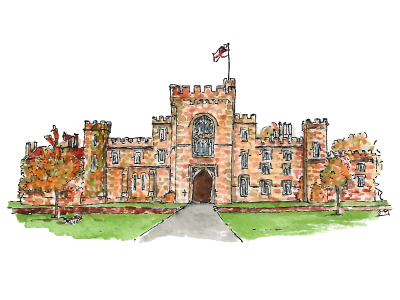Listed Building Surveys: Your Guide to a Historic Home
A listed building survey is a specialist, in-depth inspection that goes beyond a standard Level 3 Building Survey. It is performed by a RICS-accredited surveyor with knowledge of historic building materials, construction techniques, and the legislation that protects these properties.
As a general rule, if the property was built before 1850, such as Tudor, Pre-Georgian, or Georgian, and it retains a significant proportion of its original condition, it is likely to be listed. Many listed buildings will also be located in a conservation area.
When you buy a listed building, a standard home survey is simply not enough. Listed building surveys look for common defects found in historic properties, such as damp, timber decay, and unauthorised alterations. This report helps you budget for future repairs, apply for consent, and potentially avoid a costly mistake.
With a listed property, it is often what you can't see at first glance that can prove to be the most costly to remedy. We cover in detail what a specialist survey covers and the unique defects that can be found in a Grade 1 or Grade 2 listed building.
What survey do you need for a Listed Building?
There are three main types of RICS surveys available to homebuyers. However, because of their age, construction, and special legal protection, a listed building requires an RICS Level 3 Building Survey, but one that a surveyor with specialist knowledge of historic properties performs. This is why it is often referred to as a ‘Listed Building Survey’.
While a standard Level 3 survey is comprehensive, a specialist surveyor goes further by:
- Inspect unique materials and construction: The surveyor will examine traditional building methods such as ttimber frames, lime plaster, and stone masonry. They understand how these materials behave differently from modern materials.
- Identify specific defects: A specialist will look for common issues in older buildings, such as damp caused by improper cement mortar, or timber decay from poor ventilation. They can also spot poorly reproduced windows or doors that have not been installed correctly.
- Review unauthorised alterations: A specialist surveyor will be able to identify any past alterations that may have been made without the proper listed building consent. Carrying out such work is a criminal offence, and you could be liable for the costs of fixing it.
This is why it's crucial to hire an expert. A surveyor who does not have specific experience with historic properties may recommend a cheaper, less suitable survey or miss critical issues that could be costly to fix.
What is Listed Building consent?
Listed building consent is a type of planning permission required for any work that would affect the special character of a listed building.
It is a criminal offence to carry out work that requires consent without getting it first. Your surveyor will be able to identify any past alterations that may not have had the proper consent.
In our recent survey, 16% of homeowners found defects; including 2% who were able to pull out of a bad purchase, 7% who were able to negotiate a better price, and sadly, 7% of homeowners who did not get a survey and discovered defects after the purchase.
12 of the 39 who remembered how much these defects cost to remedy spent over £5,000
Don't burn your money, book a survey.

Common defects found in Listed Buildings
Historic properties have unique characteristics that can lead to specific defects, especially if they have been repaired with inappropriate modern materials.
A specialist surveyor knows what to look for beyond a simple visual inspection. Common issues include:
- Damp and Moisture: Unlike modern homes with a damp-proof course, historic buildings were designed to "breathe." Issues often arise when past owners have used non-breathable materials like cement mortar or waterproof paints, which trap moisture and can lead to serious decay.
- Timber Decay: Moisture ingress from faulty gutters, leaking roofs, or poor ventilation can lead to wet or dry rot in timber frames and floor joists. A specialist can identify the type of decay and advise on the right course of action to protect the building's original fabric.
- Unauthorised Alterations: A listed property's status applies to the entire building, inside and out. Your surveyor will look for alterations that may not have had the proper listed building consent. Carrying out such work is a criminal offence, and you could be liable for the cost of reversing it.
Do I need a structural survey for a Grade 2 listed building?
Yes. A listed building structural survey is the most thorough inspection you can get for a historic property. Because a Grade 2 listed building survey assesses the building’s unique structure, it is considered a specialist structural survey.
It will give you a detailed report on the condition of the foundations, load-bearing walls, and roof, which is essential for these properties.
How much does a Listed Building Survey cost?
A listed building survey cost will be significantly higher than a standard RICS Level 3 survey. The reason is the extra time and specialist expertise required from the surveyor on-site, in their research, and when writing the report.
While costs vary greatly based on the property’s size, grade, and location, you can expect the cost to be in excess of £1,000.
For example, a Grade 2 listed building survey cost might be in the range of £720 to £5,240, depending on the property's size and complexity.
This is a crucial investment that can help you avoid unexpected and expensive repair bills in the future, so skimping on the cost here isn't negotiable.
Call or send us a message to request a callback or an email answering your queries about our surveys.
Our UK-based survey team can help you choose the right level of home survey for your property, at no extra charge.
There's no obligation to instruct. We'll make sure you understand your options and provide a free, fixed-fee quote for our best-value survey to meet your needs.
No robots, no call centres. Property challenges solved.
Andrew started his career in 2000 working within conveyancing solicitor firms and grew hands-on knowledge of a wide variety of conveyancing challenges and solutions. After helping in excess of 50,000 clients in his career, he uses all this experience within his article writing for SAM, mainstream media and his self published book How to Buy a House Without Killing Anyone.
Caragh is an excellent writer and copy editor of books, news articles and editorials. She has written extensively for SAM for a variety of conveyancing, survey, property law and mortgage-related articles.










